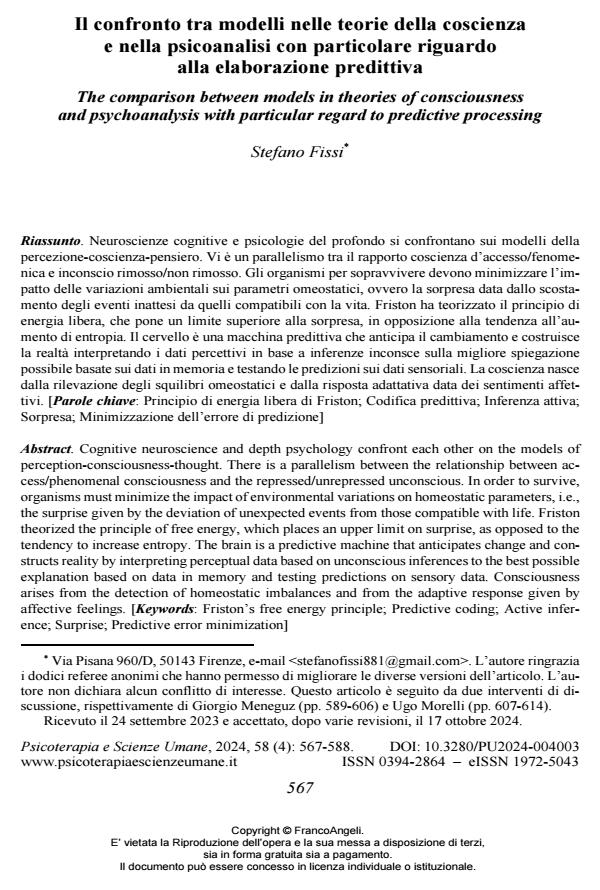The comparison between models in theories of consciousness and psychoanalysis with particular regard to predictive processing
Journal title PSICOTERAPIA E SCIENZE UMANE
Author/s Stefano Fissi
Publishing Year 2024 Issue 2024/4
Language Italian Pages 22 P. 567-588 File size 194 KB
DOI 10.3280/PU2024-004003
DOI is like a bar code for intellectual property: to have more infomation
click here
Below, you can see the article first page
If you want to buy this article in PDF format, you can do it, following the instructions to buy download credits

FrancoAngeli is member of Publishers International Linking Association, Inc (PILA), a not-for-profit association which run the CrossRef service enabling links to and from online scholarly content.
Cognitive neuroscience and depth psychology confront each other on the models of perception-consciousness-thought. There is a parallelism between the relationship between ac-cess/phenomenal consciousness and the repressed/unrepressed unconscious. In order to survive, organisms must minimize the impact of environmental variations on homeostatic parameters, i.e., the surprise given by the deviation of unexpected events from those compatible with life. Friston theorized the principle of free energy, which places an upper limit on surprise, as opposed to the tendency to increase entropy. The brain is a predictive machine that anticipates change and con-structs reality by interpreting perceptual data based on unconscious inferences to the best possible explanation based on data in memory and testing predictions on sensory data. Consciousness arises from the detection of homeostatic imbalances and from the adaptive response given by af-fective feelings.
Keywords: Friston’s free energy principle; Predictive coding; Active inference; Surprise; Predictive error minimization
- Oltre il meccanicismo e il cognitivismo: la relazione e l'esperienza. Ovvero l'ansia della causa prima. Note a margine dell'articolo di Stefano Fissi "Il confronto tra modelli nelle teorie della coscienza e nella psicoanalisi con particolare riguardo alla elaborazione predittiva" Ugo Morelli, in PSICOTERAPIA E SCIENZE UMANE 4/2024 pp.607
DOI: 10.3280/PU2024-004005 - Paolo Rossi, storico della filosofia, e i suoi interessi per la psicologia e la psicoanalisi Alberto Merini, Paolo Migone, in PSICOTERAPIA E SCIENZE UMANE 4/2024 pp.615
DOI: 10.3280/PU2024-004006 - L'energia libera della coscienza. Note a margine dell'articolo di Stefano Fissi "Il confronto tra modelli nelle teorie della coscienza e nella psicoanalisi con particolare riguardo alla elaborazione predittiva" Giorgio Meneguz, in PSICOTERAPIA E SCIENZE UMANE 4/2024 pp.589
DOI: 10.3280/PU2024-004004
Stefano Fissi, Il confronto tra modelli nelle teorie della coscienza e nella psicoanalisi con particolare riguardo alla elaborazione predittiva in "PSICOTERAPIA E SCIENZE UMANE" 4/2024, pp 567-588, DOI: 10.3280/PU2024-004003